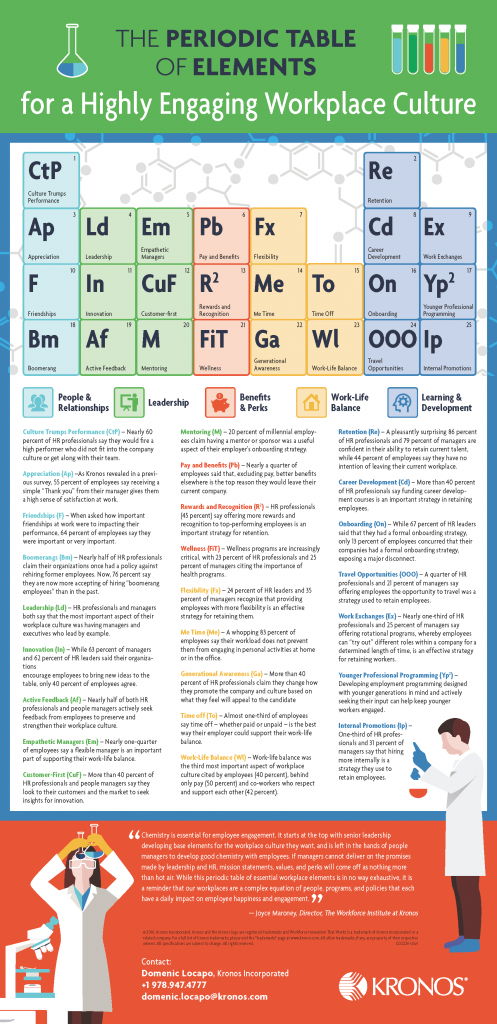A Highly Engaged Workplace Culture: Essential Elements
(Editor’s Note: Today’s post is brought to you by Kronos, the global leader in delivering workforce management solutions in the cloud. Kronos has launched a new workforce analytics as a service offering that allows small and midsized businesses to understand how labor hours are being spent by visualize workforce data using interactive technology. Enjoy the post!)
You guys know I’m a long-time volunteer leader with the Society for Human Resource Management (SHRM.) One of the volunteer roles I held was chair of the HR Florida Conference. The conference theme during my year as chair was “The Art of Human Resources.” After reading the third and final study from The Workforce Institute at Kronos, it looks like there’s a little science to HR as well.
As a reminder, the last study focused on who owns culture. The short answer: we all do, but that shouldn’t stop you from checking out the data. In this study, respondents identified the 25 essential elements of an engaged company culture. Because owning culture and the elements of it are two very different things.
There are five major areas in company culture: relationships, leadership, compensation, work, and learning. There’s a lot more information in this report so be sure to take a look at the complete findings. Here are some interesting results to note:
- HR professionals claim their organizations used to have policies against rehiring employees, but with talent wars heating up, seventy-six percent (76%) indicate they’ve become much more accepting of boomerangs.
- There’s a major disconnect with onboarding. Sixty-seven percent (67%) of HR professionals say they have a formal onboarding process compared with 13 percent (13%) of employees.
- Nearly 25 percent of employees say having an empathetic and flexible manager is an important part of their work-life balance.
- Wellness programs are increasingly popular, with almost a quarter of respondents citing their importance.
- One-third of employees say time off is the best way their organization can support their work-life balance.
The real takeaway for me was that company culture has so many elements. And those elements are dynamic – both as a single element and combined with other elements. It’s like the periodic table. The Kronos graphics team did a fantastic job of representing culture like the periodic table.
If we think about company culture like the periodic table, then we use the analogy to encourage managers to be like a chemist. The science nerd in me says this could be a new and fun way to present classic messaging about the importance of company culture. For example:
- Create your own company culture “periodic” table. Whether it’s literally or figuratively, make sure everyone in the organization understands what makes up the company culture and how they contribute to it. This can take place on career sites, during onboarding, and at company training.
- Use the individual elements to design formulas for success. Think back to chemistry class for some of the common compounds we learned. For example: rubbing alcohol is also known as isopropyl alcohol and known by the chemical formula (CH3)2 And laughing gas is dinitrogen oxide represented by the formula N2O. Apply the same idea to the workplace.
- Work-Life Balance happens when managers are empathic and flexible regarding “me” time. The formula for work-life balance is WI = Em + Fx + Me.
- Employees stay with companies when they have friends at work, are appreciated for a job well done, and receive career development opportunities. The formula for Retention is Ap + F + Cd.
As human resources professionals, we have to find new ways to communicate the same messaging to our audience. I don’t think it’s a surprise that concepts like work-life balance are important to employees. But packaging the conversation a little differently could resonate in a way that may not have in the past. Or simply add a “big bang” to a concept that’s already working.
As I mentioned, this post only scratches the surface of the data presented in the report. Be sure to download the full report from The Workforce Institute website. Also you can listen to a couple of related podcasts on “Who Owns Company Culture?” and “Kronos CEO Aron Ain on the Importance of Workplace Culture.” The culture conversation isn’t going away anytime soon.
5